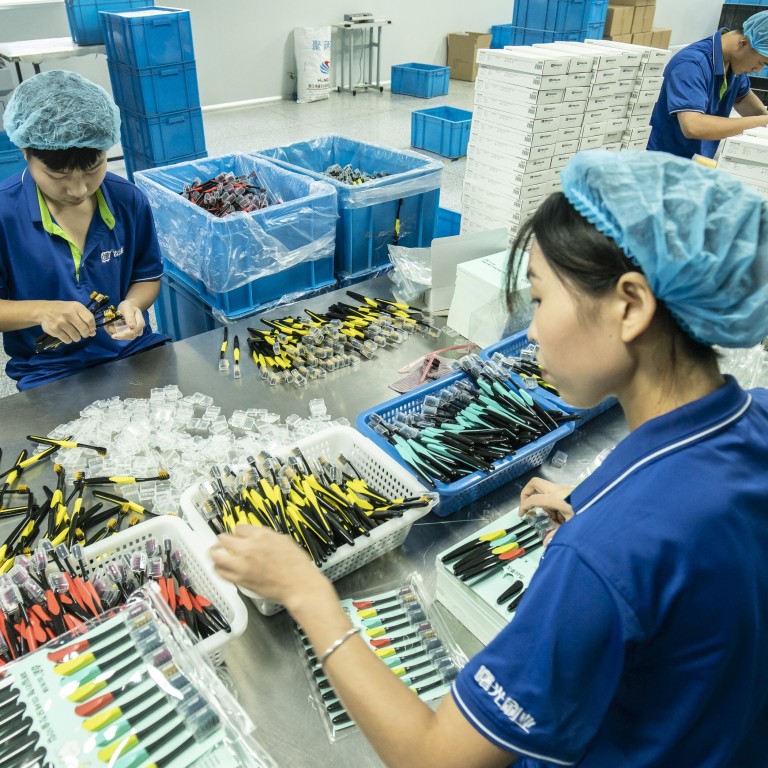
China’s economic rebound shows upside to ‘stringent lockdowns, testing, tracking’, analysts say
- Recovery in world’s second-largest economy looked more balanced in the third quarter of 2020, with services gaining momentum and growth set to continue into 2021
- Questions raised about historical revisions to economic data, even if general consensus is that China’s economic rebound is genuine
Powered by an early and severely enforced spate of lockdowns, nationwide test-and-trace campaigns, and a huge domestic market that has finally started to deliver a rebound in consumption, China’s economic recovery from the coronavirus pandemic continued in the third quarter – albeit at a slower pace than economists had expected.
The economy expanded by 4.9 per cent between July and September, compared with a year earlier, driven by an uptick in the services sector and consistent strength in trade and industry.
Economists had expected growth of more than 5 per cent, suggesting “the market had become too optimistic about the Chinese economy after the strong rebound in the second quarter”, said Zhou Hao, senior emerging markets economist at Commerzbank.
“The Chinese economy basically completed its recovery in the second quarter, so it is natural that the quarter-on-quarter growth rate would decline sharply,” said Zhou, who pointed out that the pace of quarterly growth had dipped to 2.7 per cent between the second and third quarters, after reaching 11.5 per cent between the first and second quarters.
Nonetheless, China’s economy looks more balanced than it did in the first half of 2020, when factories pumped out supply even as consumer demand struggled to keep pace. In September, retail sales grew at the fastest pace since December, while industrial production reported its fastest year-on-year expansion for 18 months.
As Western economies continue to veer in and out of partial lockdowns, with fresh spikes in coronavirus infections across Europe and the United States, the contrast with China and other economies that pursued early and consistent measures in dealing with the virus is becoming starker.
With that in mind, analysts say China’s rebound is not rocket science.
“China’s quick recovery was a product of its stringent lockdowns, massive testing, population tracking, a large economy that can afford to be somewhat insulated, and fiscal stimulus via credit expansion,” wrote Lu Ting, chief China analyst at Nomura.
Renewed lockdowns in Europe will keep consumers purchasing the personal protective equipment and stay-at-home goods categories fuelling Chinese exports
Nor does the pandemic’s ravaging of Western economies necessarily spell bad news for China.
“Renewed lockdowns in Europe will keep consumers purchasing the personal protective equipment and stay-at-home goods categories fuelling Chinese exports,” they wrote.
As always with China’s official economic data, though, veracity is the elephant in the room, even if the overall growth trajectory is clear. The National Bureau of Statistics (NBS) has engaged in a series of historical seasonal adjustments in recent months, which have helped elevate the third-quarter growth figures.
For instance, fixed-asset investment (FAI) for September would have fallen by 30 per cent year on year had it not been for an NBS revision to previous years’ data, but instead it was reported to have grown by 3.37 per cent in September, or 0.8 per cent for the first nine months of 2020. The NBS also revised historical retail sales data in August.
An NBS official confirmed to the Post on Monday that last year’s FAI had been revised. “The methods of revision are complex and differ on sector. We got the 0.8 per cent growth based on the revised data and a fully comparable base.”
“If the absolute value of FAI is correct for the first three quarters, then both investment and retail sales shrank noticeably in the third quarter year on year. GDP change would be close to a fall of 5 per cent, not growing 5 per cent,” said Derek Scissors, chief economist at the specialist research house China Beige Book.
Over the weekend, central bank governor Yi Gang said Beijing was targeting 2 per cent growth for the full year of 2020. To do so would require growth higher than 6.3 per cent in the final quarter.
Analysts are divided over whether that is achievable in reality, though the NBS’ padding of official numbers show that targets are always attainable in theory.
The current recovery has marched to a more comprehensive pickup in both demand and supply sides, from an earlier supply-driven structural rebound
Nevertheless, there are plenty of potholes to avoid, including a fresh wave of domestic coronavirus infections, a pandemic-led depression of the global economy, and ongoing US-China tensions, which have upended China’s technology sector.
“That will complicate the outlook through the remainder of 2020. It’s unlikely we’ll see economic growth return to the levels needed in October-December to deliver annual expansion of above 2 per cent. In light of the weak global picture,” said Nick Marro, global trade lead at the Economist Intelligence Unit, who expects 2020 growth of “around 1.7 per cent to 1.9 per cent”.
Shen Jianguang, chief economist at Chinese fintech firm JD Digits, was more optimistic, predicting that the broader-based recovery in the third quarter pointed to growth of up to 2.3 per cent this year, and more than 9 per cent next year.
“The current recovery has marched to a more comprehensive pickup in both demand and supply sides, from an earlier supply-driven structural rebound,” he said.
Additional reporting by Frank Tang


